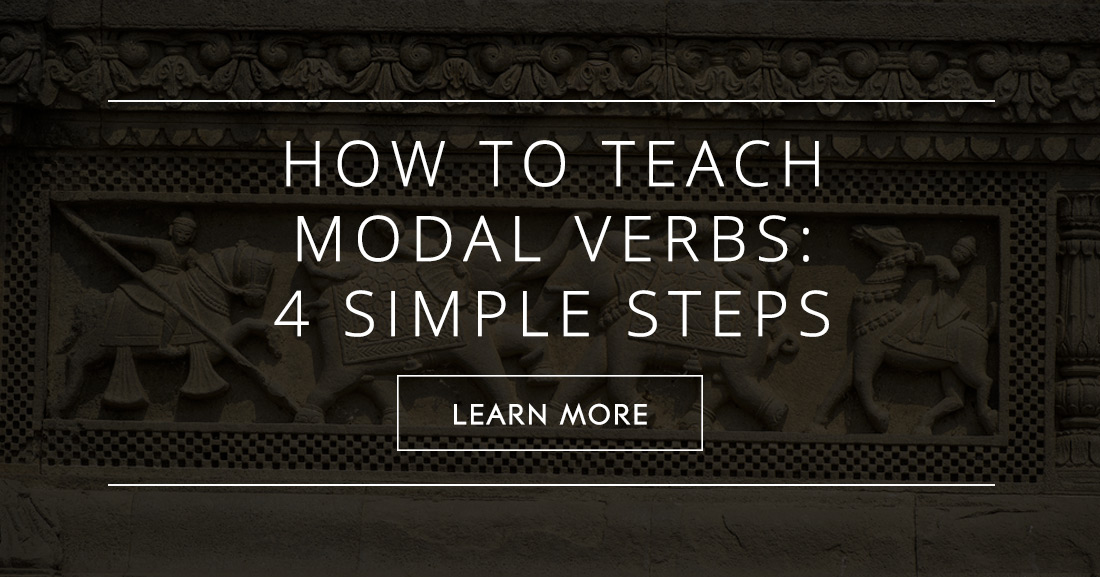
English language learners are often confused by modal verbs because they are used differently than other verbs and in a wide variety of situations such as asking for permission and giving advice. There are a couple methods you can use to teach students modal verbs. One is to introduce only a few words at a time and complete several practice activities before attempting to introduce additional vocabulary. Another way you can teach modal verbs is to structure your lessons around their uses. You could leave all the modal verbs written on the board for the whole chapter but use only the ones appropriate for giving advice in one lesson and asking for permission in another for instance.
Let’s look at the second method in more detail.
Follow These Steps To Teach Modal Verbs
-
1
Introduce all modals
Start by introducing all the modal verbs you wish to talk about. This may include can, could, may, might, must, will, would, shall, should, and ought to but, depending on the level of your class, you can narrow it down to those you feel are most important. Obviously there are no images that can help students understand the meanings of these words so you can do pronunciation practice simply by pointing to the words on the board. In your introduction you can cover some rules that apply to all modal verbs. Unlike most verbs, no -s is needed to form the third person singular. For example “He should ~.” is correct, while “He work.” is incorrect. Adding not forms the negative structure. Additionally they always require another verb because they cannot act as the main verb in a sentence and they only have present tense forms so unlike the word swim, there is no past tense form for modals. This may seem like a long and confusing introduction but it is best after the pronunciation practice to simply write the modals and their rules off to the side of the board for reference.
-
2
Ability/Inability and Possibility/Impossibility
Modal verbs are often used to talk about abilities and possibilities or lack of them. Some of the words you want to focus on in this section are can, could, may, and might. Talk to your students about things they can do and practice using can in the target structure because this will be the easiest word to start off with (see our CAN worksheets). Next you should talk about might because it is also commonly used when talking about present possibilities such as “We can’t play music in class because the other classes might be taking tests.” which nicely combines the two words in one sentence. Building upon that, talk about how could and may are used to discuss future abilities and possibilities and also how could can be used to talk about the past in a sentence such as “When I was a child, I could climb trees.” So as you can see just this one section on modals can take a while. It is best to introduce structures gradually and to plan lots of practice activities for each.
-
3
Other Uses
You can center another lesson on asking for permission or making an offer or request. Can, could, may, shall, will, and would can all be used so you might want to break this up into pairs by introducing can and could, will and would, and finally may and shall. In other lessons you can cover using modals to make suggestions and give advice, to talk about obligations and prohibitions, and lastly cover using ought to and should to say what the correct action would be for instance “She ought to see a doctor.” or “We should be quiet while the teacher is talking.” For some classes it is not necessary to cover all the different uses of modal verbs so feel free to choose what is most important and then cover those items thoroughly before moving on to the next topic.
-
4
Combination
If you cover many different uses of modal verbs in your class, be sure to have a lesson which combines them again. It makes sense to start with all the words you plan to cover in the first class and finish the same way. Since students have been focusing on just one use at a time, this lesson will bring to their attention the range of uses these words have and really challenge them. Fill in the blank and multiple choice worksheets may be appropriate and of course you can conduct role plays based on the different uses of modal verbs too.
Why are Modal Verbs Useful?
Modal verbs include the words ‘can,’ ‘could,’ ‘may,’ ‘might,’ ’must,’ ‘will,’ ‘would,’ ‘shall,’ ‘should,’ and ‘ought to.’ They are flexible and have several different uses in the English language. Here are a few of the more common examples:
Obligation or Command: ‘Have’ and ‘must’ When say to your class: “You must return your library books today.” “You have to finish the test before 12.00.” These are instructions are obligations and thus things they have no choice in.
Permission or Possibility: ‘Can’, ‘could’ and ‘may’ These verbs are to give or ask for permission. These help us to ask polite questions. “Shayna, can you please pass me that book?” “Could you please help me tidy my desk?” "Do you think you can visit tomorrow?".
Advice or Suggestion: ‘Should’, ‘ought to,’ ‘had better’ Modal verbs are often used to give advice, for example. “I think you should join the baseball team.” “You ought not to interrupt your teacher when she is speaking.” “You had better admit that you made a mistake.”
Prohibition: ‘Can’t’ and ‘mustn’t’ You can use modal verbs to give orders, or set rules or boundaries. ”You can’t leave your books on the floor.” “You mustn’t forget to provide sources for your research.”
Modal verbs have many uses. Teachers should review the uses of modals carefully before introducing them and think about what students would most benefit from studying so that plenty of time can be dedicated to those items. Leaving out some modals or some uses of modals is not the end of the world and may just give your students a better chance of understanding what is covered.
See our Modal Verbs worksheets section.
P.S. If you enjoyed this article, please help spread it by clicking one of those sharing buttons below. And if you are interested in more, you should follow our Facebook page where we share more about creative, non-boring ways to teach English.








